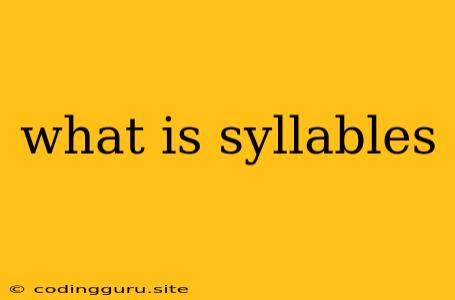What is a Syllable?
Have you ever wondered why some words seem easier to pronounce than others? The answer lies in the building blocks of spoken words: syllables. Syllables are the individual units of sound that make up a word, and understanding them can be key to improving your pronunciation and reading skills.
What Makes a Syllable?
A syllable is essentially a single beat or pulse in a word. It's the unit of sound that contains a vowel sound, and potentially some surrounding consonants. Here's the breakdown:
- Vowel: Every syllable must have at least one vowel sound. Vowels are sounds made with your mouth open, like "a," "e," "i," "o," and "u."
- Consonants: Consonants can appear before or after a vowel sound in a syllable. Consonants are sounds made with your mouth partially closed, like "b," "d," "f," "g," "h," "j," "k," "l," "m," "n," "p," "q," "r," "s," "t," "v," "w," "x," "y," and "z."
How to Count Syllables
There are a few ways to count syllables in a word:
- Clap Method: Clap your hands once for each vowel sound you hear in a word. For example, "cat" has one clap, "apple" has two claps, and "elephant" has three claps.
- Vowel Rule: Look for the number of vowel sounds in a word. Each vowel sound usually represents a syllable.
- Divide and Conquer: Try to break the word down into smaller parts. Each part that has a vowel sound will likely be a syllable.
Examples of Syllables in Words:
Let's take a look at some examples:
- "cat" - One syllable (one vowel sound: "a")
- "happy" - Two syllables (two vowel sounds: "a" and "i")
- "elephant" - Three syllables (three vowel sounds: "e," "e," and "a")
Importance of Understanding Syllables
Knowing about syllables is important for several reasons:
- Pronunciation: Understanding the structure of syllables helps you pronounce words correctly.
- Reading: Recognizing syllables in words can improve your reading speed and fluency.
- Poetry: Syllables play a vital role in poetry and rhyme schemes.
- Language Learning: Understanding syllables can be beneficial when learning new languages.
Tips for Identifying Syllables
- Listen carefully: Pay attention to how you pronounce the word. How many distinct vowel sounds do you hear?
- Practice: Try counting syllables in different words. You can practice with words you encounter in books, articles, or conversations.
- Use online resources: There are many online dictionaries and tools that can help you identify syllables in words.
Conclusion
Syllables are the building blocks of language, and understanding them can improve your pronunciation, reading, and overall language skills. By learning how to identify and count syllables, you can gain a deeper understanding of the structure of words and how they are spoken.
